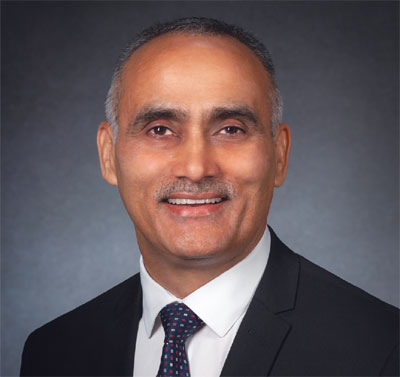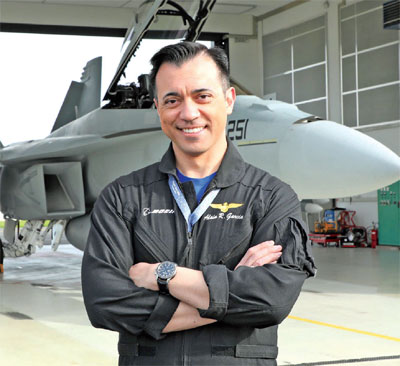We are Developing MSMEs in Support of Our Commitment to Aatmanirbhar Bharat. Over 25 Per Cent of our Suppliers from India are MSMEs

Can you talk about your engineering centre in India and how is it helping in capacity building?
Boeing India Engineering & Technology Centre (BIETC) in Bengaluru and Chennai is leveraging a talented pool of employees for innovation in aerospace. Our engineers in India undertake high-quality, advanced aerospace work spanning engineering design of structures and systems, manufacturing support, developing systems to test our airplanes and providing digital solutions to our airline customers. Cutting-edge research and development work in traditional and emerging areas is also done at BIETC, including next-generation Airplane Health Management (AHM), environment-friendly coatings, advanced networks and secure-communications, where teams leverage new-age technologies to replace traditional approaches, enhancing safety and productivity across Boeing platforms.
The Boeing India engineering design teams collaborate with our R&D teams globally to leverage Artificial Intelligence (AI) and Machine Learning (ML) methods and in the process, result in a significant reduction in time taken for tasks, and also enhancing quality. Digital aviation efforts are also helping airlines reduce fuel consumption through route optimization, and make effective utilisation of their crew. Digital engineering is being used to enhance the manufacturing environment and provide value to customers. Digital threading is being used to create a digital twin before manufacturing aircraft systems, resulting in fewer manufacturing issues. This drives efficiency, optimizes product design, and enhances manufacturability, making the end-to-end supply chain more digital.
The Boeing Research & Technology team in India has delivered commercially viable solutions for AHM and Air Traffic Management (ATM). Its ATM experts are currently working with the Airports Authority of India to develop a roadmap for air traffic management modernisation in the country. Today, the research centre is using AI and ML to continue to improve the wide-body airplanes that Boeing delivers. Using Internet-of-Things (IoT) technologies, its engineers are finding ways to improve passenger experience during air travel.
What are your various partnerships in India and what future do you see for them?
Boeing has always supported the development of indigenous aerospace and defence capabilities in India, and has through the years invested in partnerships with the Indian aerospace ecosystem in skilling, research and technology, and manufacturing. Our growing partnership with the country’s defence forces and our expanding supplier base makes it imperative for us invest in, develop, and nurture talent.
Our sourcing from India stands at $1 billion a year from 300 suppliers who are part of the global supply chain. Boeing’s industrial partners in India are raising the bar to deliver world-class quality, cost-efficiency, and productivity, as they become an important part of the company’s supply chain for some of the most advanced platforms in the world.
There are several examples where our Indian partners are global suppliers of critical parts on Boeing’s defence airplanes. We are developing MSMEs in support of our commitment to Aatmanirbhar Bharat. In fact, over 25 percent of our suppliers from India are MSMEs. For example:
- Tata Boeing Aerospace Limited (TBAL), Boeing’s joint venture with Tata, is an example of our strategic focus on Make in India. Spread over 14,000 sqft, this state-of-the-art facility with over 500 engineers and technicians, it demonstrates co-development of integrated systems in aerospace and defence in India. Our efforts in TBAL align not just with the mission of Make in India but with the Prime Minister’s call for ‘Make in India, for the World’. We say this because the Apache fuselages made in this facility in Hyderabad are meant for not just the six Apaches that the Indian Army is on contract with Boeing for, but also Apaches for customers around the world, including the US Army. As of September 2022, over 170 fuselages have been delivered by TBAL to Boeing customers across the world.
- Dynamatic Technologies manufactures the ramp and complex aft pylon for Chinook heavy-lift helicopters. They were recently awarded a contract for manufacturing assemblies for Boeing’s newest tactical fighter, F-15EX Eagle II. This is a first where aerostructures for the latest and most advanced F-15EX Eagle II will be made in India.
- Rossell Techsys manufactures wire harness and electrical panel for the AH-64 Apache, and the harness for several defence platforms including CH-47 Chinook, F-15 and F/A-18 Super Hornet. In 2022, Rossell Techsys entered into an agreement with Boeing to manufacture and supply wire harnesses for the T-7A Red Hawk platform. Rossell will be manufacturing Electrical Wiring and Interconnect System (EWIS) parts and the deliveries will continue through FY 2032, covering a total of 84 unique parts. All parts will be manufactured at Rossell’s Center of Excellence (CoE) set-up exclusively for Boeing.
- Bharat Electronics Limited (BEL) manufactures IFF (Identify Friend/Foe) and speech secrecy system for the P-8.
- SASMOS HET Technologies manufactures electrical panel assemblies for the F/A-18 Super Hornet and F-15 Strike Eagle.
- Hindustan Aeronautics Ltd (HAL) manufactures F/A-18 gun bay doors.
- Jaivel Aerospace will manufacture and supply aircraft protection system products for the Boeing T-7A Red Hawk aircraft. Working with the Boeing teams in India and the US, Jaivel Aerospace has developed entirely new capabilities for this product range, for the first time in India. These products will be manufactured at the company’s manufacturing facility at Sanand Industrial Estate in Ahmedabad.

Furthermore, in 2021, we launched the Boeing India Repair Development and Sustainment (BIRDS) Hub. BIRDS is an initiative to bring together ecosystem partners to shape India as a strategic destination for aerospace engineering, maintenance, repair and sustainment services. This is a one-of-its-kind initiative that seeks to provide customers with best-in-class solutions, efficient turnaround times, and optimal economic value, all available in-country. Partnership is Boeing’s key to success, and we believe it makes more sense to partner with local MROs that are already established and have great capabilities.
We are continuously investing in local capacity-building as well as collaborations with Indian organisations across manufacturing, infrastructure, engineering services, research and technology, training, and skills development. These collaborative programs are developing the skilled and trained workforce in India needed to build an ecosystem conducive to business success. Our Indian suppliers are our partners in the journey towards Aatmanirbhar Bharat and in making India a key hub for aerospace and defence manufacturing for the world.
Given the government acquisition policies, what is your focus in India, both in the medium and the long term?
F/A-18 Super Hornet Block III offers transformative, next-generation capabilities for the Indian Navy. It was specifically designed, from its inception, for carrier operations. The US Navy operates more than 800 Super Hornets and EA-18 Growlers, the electronic attack version of the F/A-18 and have logged over 2.5 million flight hours on the fleet. The Block III configuration is suited to protect India’s maritime interests as it’s built to meet the broadest range of missions. Boeing has invested in the new technologies in the Super Hornet Block III, including increasing the life of airframe to 10,000 hours from 6,000 hours of Block II, radar cross-section improvements and an advanced crew station in the cockpit. With the Super Hornet, the Indian Navy will get transformative capability and also enhance naval aviation cooperation between the two navies. We are also pleased with the performance of our F/A-18 Super Hornets that participated in the Operational Demonstration test flights in May and June in Goa.
Boeing plans to further strengthen its Make in India initiatives, building on a successful track record of contributing to India’s indigenous aerospace and defence ecosystem. As part of this effort, Boeing anticipates $3.6 billion in economic impact to the Indian aerospace and defence industry over the next 10 years, with the F/A-18 Super Hornet as India’s next carrier-based fighter. The economic impact would be over and above Boeing’s current offset obligations and plans in the country. Boeing plans to build on its existing industrial base and strengthen its commitment to Aatmanirbhar Bharat with continued investments in India across five pillars. These include:
- Supply chain development and manufacturing
- Engineering and technology transfer
- Long-term support and training
- Infrastructure investments
- Contributions of the Hornet Industry Team, comprising of General Electric, Northrop Grumman and Raytheon
The diversity and strength of the Hornet Industry Team, comprising of General Electric, Northrop Grumman and Raytheon, has the potential to deliver significant benefits and impact on Indian industry. These industry leaders have proven their commitment to India by collaborating with Indian entities and delivering on Aatmanirbhar Bharat objectives.

Space & Security and Global Services, Alain Garcia
The F/A-18 will enhance collaboration with Indian industry by facilitating knowledge transfer and promoting autonomy in operating and maintaining India’s fleet of F/A-18 aircraft. Further, this knowledge transfer may also provide opportunities for India to support F/A-18 fleets around the world through manufacturing and sustainment.
F-15EX: The F-15EX is the latest and most advanced version of combat-proven, multi-role, all-weather day/ night F-15 aircraft family. Given the contemporary sensors and radar, advanced cockpit and range, and speed and payload capacity, the F-15EX brings capabilities that no other fighter aircraft can offer. It offers affordability, speed, range, heavy-weapon payload and the ability to rapidly integrate new technology into a fighter aircraft. The F-15EX is setting records as the first US Air Force aircraft to be completely tested and fielded through combined Developmental and Operational Test. The first two aircraft were delivered ahead of schedule and participated in advanced exercises weeks later, achieving impressive results against sophisticated threats. Additionally, the US Air Force has contracted Boeing for increasing quantities of aircraft each year and factory production is being increased to domestic and international meet demand. Boeing is committed to increasing rate in the factory to meet the US Air Force requirements for F-15EX and new demands from our international customers.
It will excel as a candidate in India’s Multi Role Fighter Aircraft program. With next-gen technologies that provide improved survivability across a broad spectrum of environments, the complementary capabilities of F-15EX enable a more balanced force structure that will remain ahead of current and emerging threats for decades.
How is your manned-unmanned teaming programme coming along? What is the future roadmap for this programme?
Recently, Boeing digitally demonstrated a new open autonomy architecture for MQ-25 that will allow the US Navy to increase mission effectiveness by integrating manned-unmanned teaming (MUM-T) capability at speed and scale. The non-proprietary architecture, based on the government-owned Open Mission System specification, is the foundation for advanced MUM-T. A Boeing-led team virtually demonstrated how other aircraft can use MQ-25’s architecture and task it to conduct tanking and intelligence, surveillance and reconnaissance (ISR) missions—all within the mission airspace and without traditional communications with the ship-based ground control station.
Boeing’s MUM-T demonstration included Northrop Grumman’s E-2D Advanced Hawkeye command and control aircraft, Boeing’s P-8A Poseidon maritime patrol and reconnaissance aircraft and Boeing’s F/A-18 Block III Super Hornet fighter jet. Using their existing operational flight program software and data links, the aircraft safely and efficiently tasked four virtual, autonomous MQ-25s to conduct ISR missions. The F/A-18 also used its advanced tactical data links and Boeing’s conceptual ‘Project Black Ice’ crew vehicle interface, which significantly reduced aircrew workload.
For example, the demonstration showed how both the P-8A and E-2D could easily task an MQ-25 teammate with an ISR mission specifying only the search area and no-fly zones. Using an onboard autonomy framework developed by Boeing subsidiary Aurora Flight Sciences, the MQ-25 autonomously did the rest—including validating the command against its operational constraints, planning its route and conducting its search pattern, among many other tasks.
The demonstration was aligned to the future warfighting capabilities in the Navy’s Unmanned Campaign Framework. Boeing will continue to refine the autonomy, sensors, interface exchanges and crew vehicle interfaces required for MUM-T. and services that only Boeing can offer.
Boeing has come up with the Boeing University Innovation Leadership Development (BUILD) programme. What was the idea behind this initiative and how do you see it faring in the future?
The programme is aimed at encouraging young entrepreneurial minds to develop ideas that can be converted into viable business offerings, aligned with Boeing’s vision of contributing to India’s robust start-up culture.
Boeing has partnered with seven incubators: IIT Bombay, IIT Delhi, IIT Gandhinagar, IIT Madras, IISC Bangalore, T-Hub Hyderabad, and KIIT Bhubaneshwar. Applicants are invited to submit ideas in the fields of mobility, space, connectivity, Industry 4.0 technology, enterprise digital solutions, sustainability, and data analytics/AI.
At Boeing, we are committed to fostering innovation and nurturing talent through collaborations and partnerships. The burgeoning academic and entrepreneurial ecosystem in India provides a strong tailwind to the investments we continue to make in building up indigenous skills and capabilities in the country. With BUILD, we touch the entire spectrum of student-to-start-up community so they can benefit from our experience and our partner networks for developing breakthrough ideas in India, for India, and for the world.
The shortlisted teams will compete at a regional level and the finalists will pitch their ideas to subject-matter experts on Boeing Innovation Day, to be held in February 2023. The winners will stand a chance to win cash prizes. Boeing mentors and industry experts will interact and closely work with the finalists to refine and suggest ways to convert ideas into viable business offerings.

